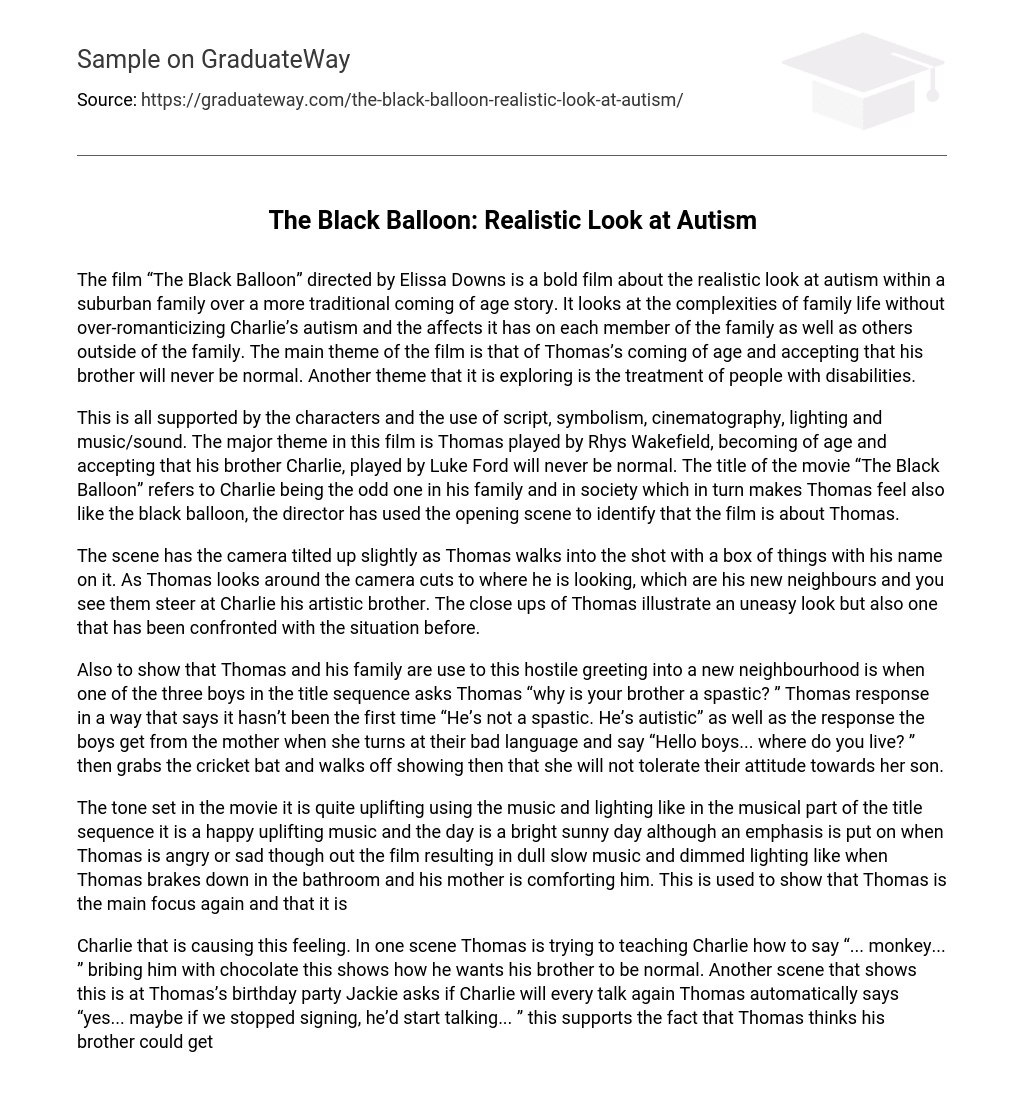“The Black Balloon,” helmed by Elissa Downs, is a daring movie that presents an authentic depiction of autism in a suburban household, straying from the conventional coming-of-age narrative. Rather than idealizing the impact of Charlie’s autism on his family and the people around them, the film candidly explores the intricacies of familial life. Thomas’s quest for acceptance takes center stage as he comes to terms with his brother’s perpetual divergence from societal norms. Moreover, the film delves into the treatment of individuals with disabilities.
The characters, script, symbolism, cinematography, lighting, and music/sound all support the theme of Thomas played by Rhys Wakefield coming of age and accepting that his brother Charlie, played by Luke Ford, will never be normal. The movie’s title “The Black Balloon” symbolizes Charlie being seen as the odd one in his family and society, which also makes Thomas feel like he’s the black balloon. The director establishes in the opening scene that the film revolves around Thomas.
The camera is angled slightly upward as Thomas enters the frame, carrying a box labeled with his name. As Thomas gazes around, the camera switches to show his new neighbors, who are staring at his artistic brother, Charlie. Close-up shots of Thomas capture a mix of unease and familiarity with the situation.
The text reveals how Thomas and his family have become familiar with the unwelcoming reception in their new neighborhood. This is evident when one of the boys at the beginning asks Thomas about why his brother is called a “spastic”. Thomas replies saying, “He’s not a spastic. He’s autistic.” Furthermore, the mother responds to the boys’ inappropriate words by addressing them and asking, “Hello boys… where do you live?” She then grabs a cricket bat and leaves, clearly showing that she will not tolerate their disrespectful treatment towards her son.
The movie establishes an uplifting atmosphere by employing music and lighting. During the musical portion of the title sequence, cheerful and uplifting music plays while a bright and sunny day is depicted. Conversely, when Thomas experiences anger or sadness throughout the film, the music becomes monotonous and slow-paced, accompanied by dimmed lighting. This effect is especially noticeable during a scene in which Thomas breaks down in the bathroom and receives comfort from his mother. These techniques are utilized to redirect focus onto Thomas and his emotional state.
The text suggests that Charlie’s behavior is the cause of a particular feeling. One instance highlighting this is when Thomas attempts to teach Charlie to say “monkey” by incentivizing him with chocolate, demonstrating his desire for his brother to be typical. Another example is at Thomas’s birthday celebration, where Jackie inquires if Charlie will ever speak again. In response, Thomas promptly asserts, “yes… maybe if we ceased using sign language, he would begin talking,” indicating his belief in the possibility of his brother’s improvement.
In the film, there are multiple instances where Charlie and other disabled individuals are mistreated or ignored by others, thus illustrating another underlying theme. These scenes shed light on society’s inability to accept those who are different and behave differently from the so-called norm. For instance, when the Department of Community Services visits the family, it reveals that the neighbors do not accept Charlie’s behavior, despite being aware that he cannot control it. Similarly, at the shop, others stare at him when he gets upset and throws a tantrum.
This film is highly effectively constructed due to its utilization of characters, script, cinematography, lighting, and music/sound. Moreover, it provides audiences with an understanding of the challenges faced by a family with an autistic member. Additionally, it beautifully portrays the emotional journey of Thomas as he grows up with a non-conventional brother, showcasing acceptance of their situation. Remarkably, the film manages to evoke genuine laughter and tears, creating a realistic depiction of a troubled family.





